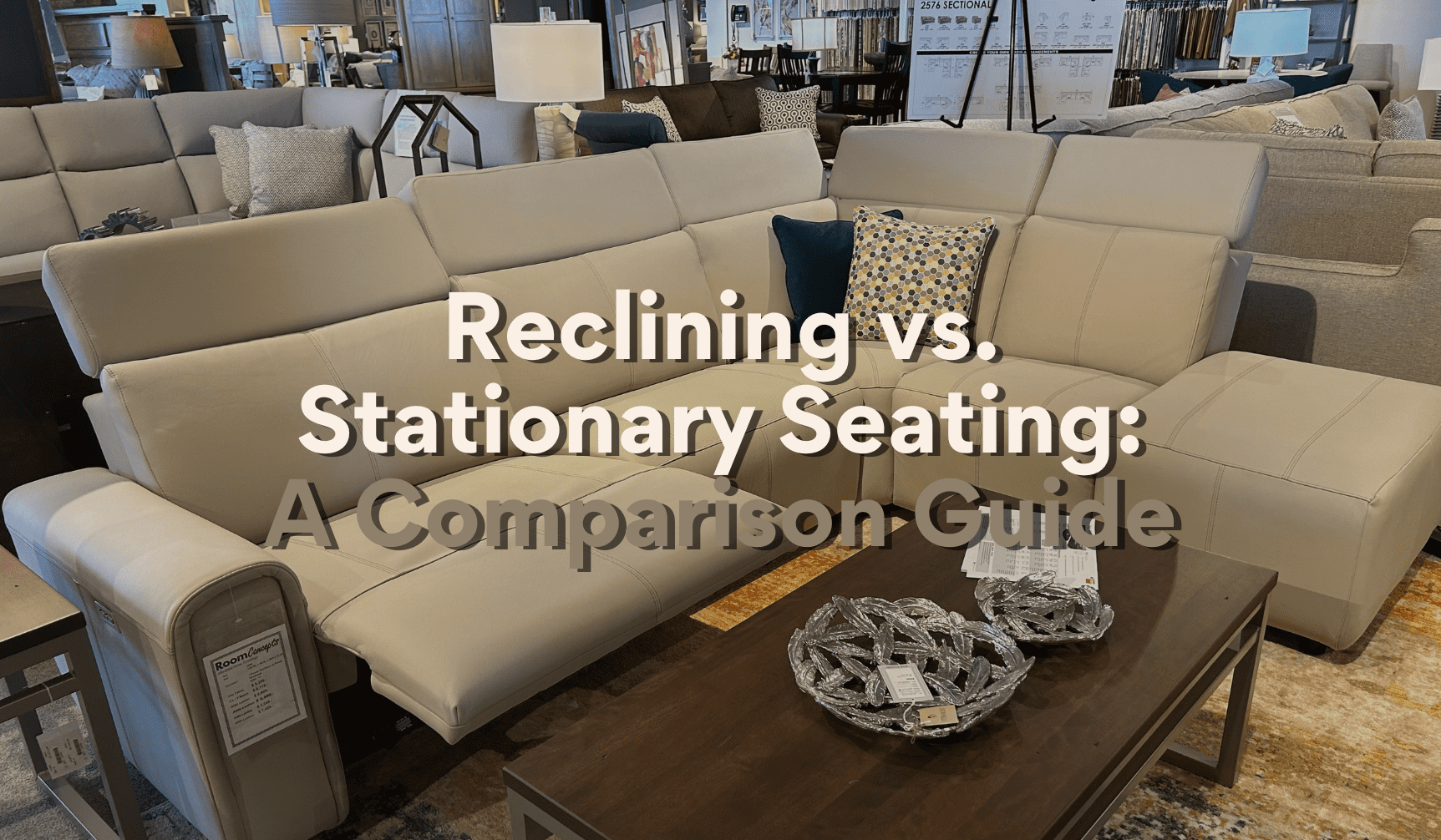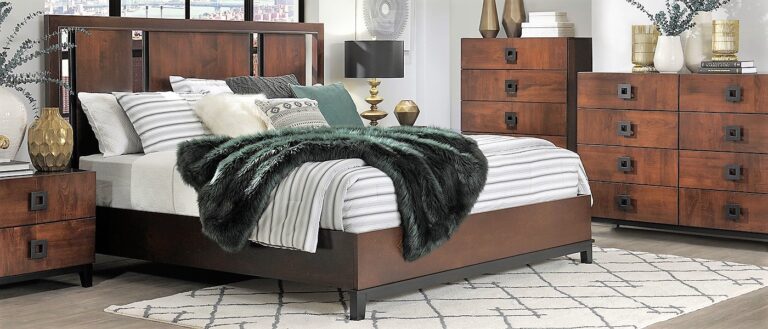When it comes to designing a living room, your choices may seem endless–especially when deciding between reclining vs. stationary furniture. Stationary, “regular” furniture is easier to browse, and there are more style variations available; however, reclining sofas and other types of reclining furniture adds so many possibilities when it comes to comfort, and for many, a reclining sofa or chair offers the perfect solution to recovery after a hard day’s work.
No matter what phase of your furniture shopping experience, having a copious amount of choices can be overwhelming. We can help make it a little easier for you by guiding you through some of the key differences between reclining and stationary furniture to help you decide whether reclining furniture is worth your consideration. Both options have notable pros and cons, so let’s break it down to help you make a well-informed decision, starting with the pros and cons of reclining furniture.
What Is Reclining Furniture?
Reclining furniture is a piece of furniture that reclines when the occupant lowers the chair’s back and raises its front. It has a backrest that can be tilted back, and often a footrest that may be extended by means of a lever on the side of the chair or sofa, or it may extend automatically when the back is reclined. Some recliners are manual recline, meaning they have a traditional lever mechanism, while others are power recline and use an electric motor. These may either be battery operated or rely on a power cord.
Most people are familiar with the concept of a “recliner,” which, when used colloquially, typically refers to a comfortable reclining chair for one person. Although these recliner chairs are popular and we carry plenty of them here at Room Concepts, there are many other configurations of reclining furniture as well to choose from, including reclining sofas and reclining sectionals.
Reclining furniture, especially sectionals, have many possibilities when it comes to customization. With some models, you can also choose whether or not to include a reclining headrest. You may also specify which part of the recliner sofa or sectional you want to recline, and which part you want to remain stationary, since not every seat may be equipped with a reclining mechanism. Modular reclining sectionals may even allow you to adjust the order of the seating if you would like to “switch” which part of the sectional reclines.
What Are The Benefits of Reclining Furniture?
Flexible Posture
Reclining furniture options give you the flexibility to sit upright or recline. If you’re a nap lover, reclining pieces are your best friend! Many modern reclining furniture is also designed to be more compact and subtle, making it nearly indistinguishable from regular furniture. If you want furniture that reclines but dislike the sometimes “bulky” look of older recliners, we have sleek options from brands like Elran that combine reclining mechanisms with unquestionable style.
Unbeatable Support Both Ways
Many consumers say they are generally more comfortable with ample support both when the recliner sofa is upright as well as reclining.
Health Benefits
Use of reclining furniture can reduce back pain and provide lumbar support. Some models are better for this than others, so make sure to ask about these additional features when shopping for your reclining furniture.
Encourages Stress Relief and Relaxation
Reclining promotes relaxation, therefore relieving stress.
What Are The Disadvantages of Reclining Furniture?
Higher Price Point
Reclining furniture tends to be more expensive because it’s more labor-intensive to build. The reclining mechanisms also typically have warranties attached.
Possible Maintenance Needs
Recliners have the potential for more service issues because with the movement and mechanics involved, there is more that can go wrong than with regular furniture.
Smaller Customization Variety
Reclining furniture options tend to have less available fabric choices because most people do not use them as accent pieces. However, if you are buying reclining furniture from brands like Elran, you will still find that there are over 300 fabric/leather choices so plenty of options for customization.
Aesthetic Concerns
If you’re particular about the look of your furniture, understand that reclining furniture backs will most likely not align perfectly 100% of the time. While this is not necessarily a deal-breaker if you are looking to buy reclining furniture, it is nevertheless something to be aware of as you are deciding where in the room to place your furniture.
Also, it is worth mentioning that no matter how modern and sleek some reclining furniture may look, it will not always suit everyone’s style, particularly if your home is more traditional, and the available variety will always be a bit more limited than what you can buy from the realm of stationary pieces, even with customization.
How Much Room Does a Recliner Need?
So, you’re ready to buy a recliner. Now begins the potentially challenging task of identifying the appropriate area for this dynamic piece of furniture. The first step in determining how much space a recliner needs is to measure the living area or space where it will go. A general rule of thumb is to allow five to ten inches of space between the recliner head and the closest wall.
If you have a smaller room and space is limited, a wall hugger can be a great solution. Wall huggers can be placed closer to walls, as they move forward when reclining. At Room Concepts, we have a highly experienced team of design experts who can help you choose the style and size to fit your unique needs.
How Long Do Recliners Last?
Like anything else, this will depend on the brand or quality you buy. Generally speaking, recliners can last anywhere between three to ten years. Leather recliners may last even longer. Factors that can affect a recliner’s lifespan include usage, maintenance, quality materials of the furniture itself, and the person using the recliner. Heavy or daily usage can result in a shorter life span for an item than one that experiences infrequent or seldom usage. The size of the person using the recliner will also have an impact. Most recliners will function fine under normal conditions even with frequent use; however, if the main user is a larger person, that will put more strain on the mechanisms over time.
Finally, and perhaps most importantly, purchasing a piece of reclining furniture with quality materials and craftsmanship will result in a longer lifespan. At Room Concepts Furniture, we have customizable and high- quality, customizable reclining furniture options to meet your needs and we expect our recliners to last eight to twelve years.
Is It Better to Get a Manual or Power Recliner?
The answer depends on your budget, ease of use, and long term value. If you’re operating on a tighter budget and don’t mind the extra effort, a manual recliner may be the perfect fit for you. If you have a larger budget and are looking for ease of use, ultimate flexibility, and long term value, you may want to consider a power recliner.
It is also worth considering the fact that manual recliners require leg muscle to put them down. It is worth asking yourself, even if you are able to do that today, will you have the strength to do so in 10 or more years? If you are looking for a piece of reclining furniture you can keep around forever, you might want to consider the long-term benefits of a power recliner. No matter your preference, Room Concepts has both manual and power recliners to satisfy your needs. You can also choose to add memory foam, lumbar and even zero gravity reclining to give you the utmost comfort.
Can a Recliner Be Stylish?
The short answer is yes, recliners can absolutely be stylish and fit within a modern home. At Room Concepts, every piece of furniture can be customized to fit your specific style and preferences. Choose from 300 different fabrics and leathers to create a custom recliner that fits perfectly with your existing living room furniture.
What is Stationary Furniture?
Unlike reclining furniture, stationary furniture cannot move or adjust when a person sits on it, and it is characterized by a fixed back and seat. Although recliners can undoubtedly be stylish, stationary pieces are usually considered more elegant than reclining furniture. Many consumers use stationary chairs and sofas as accent pieces in their living spaces and/or bedrooms, which can make the design of the room pop.
So, is a recliner better than a regular sofa or chair? Let’s dive into the pros and cons of stationary furniture next.
What Are The Benefits of Stationary Furniture?
Lower Price Point
Stationary furniture is often less expensive than recliners. While this varies by brand, a moderately priced stationary piece will probably cost less than a moderately priced reclining piece, and the same can be said for luxury counterparts–a luxury stationary item will cost less than a luxury recliner. This is because of the added construction and labor involved in creating a recliner vs. a stationary furniture piece.
Lower-Maintenance Furniture
Stationary pieces have less service issues than recliners, due to less moving parts.
More Customization Options
Stationary pieces offer a multitude of options when it comes toith style, fabric, color, size, etc.
Other Fun Additions
Stationary furniture usually comes with toss pillows which can provide even more comfort, design and flexibility in a room. Toss pillows are less practical for use with reclining furniture, but that may be considered a downside by some who prefer the aesthetic of additional pillows and accessories.
Enhance Comfort in Simpler Ways
Stationary furniture may require more creativity when it comes to achieving a peak level of comfort, but there are many practical ways to do this without needing to buy a recliner. Adding an ottoman or a cushioned coffee table can provide you with the same amount of relaxation provided by a recliner, and these items often can double as storage as well.
What Are the Disadvantages of Stationary Furniture?
Limited Functionality
An upright seating position is the only available option with stationary furniture, unlike the alternatives provided by reclining furniture.
Less Relaxation Potential
Without the ability to recline, you may miss out on the full relaxation potential that comes with a reclining furniture option. However, stationary furniture is still the standard in most households, and there are still plenty of stationary sofa and sectional options that deliver optimal comfort. These just may not have the same premium comfort advantage offered by reclining furniture. As with any other furniture decision, the choice is ultimately yours about how you prefer to relax.
Ready To Find The Right Furniture Option For You? Let Us Help You Choose!
Whether you’re looking for reclining or stationary furniture, we have you covered. All of our living room furniture is made in the U.S. or Canada, and it all comes backed by a manufacturer’s lifetime warranty on the springs and frames, and at least a 5-year warranty on the seat cushions.
We have many different styles and possibilities for living room furniture to choose from and would love to help you find the perfect option for your home and lifestyle. Our team of experts can provide you with the information needed to make the best choice for your budget and lifestyle. Contact us today!







